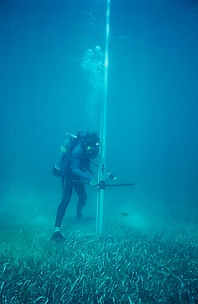top of page

University of California, Davis
Coastal and Marine Sciences Institute
(Bodega Marine Laboratory)
and
Dept. of Wildlife, Fish & Conservation Biology
BIOTURBATION
The process by which organisms disturb sediments (bioturbation) is an important driver that structures many soft benthic (bottom) communities around the world. The key players can involve invertebrates, fish, and marine mammals, including whales. They may disrupt sedimentary layers making dating and sequencing much more difficult, or negatively impact natural communities such as sea grass beds, or benthic invertebrates.
• U.S. VIRGIN ISLANDS: Using SCUBA, Tom evaluated the influence of bioturbation by deep-burrowing callianassid and upogebiid ghost shrimp in shallow tropical lagoons of St. Croix, U.S. Virgin Islands to show how they influence sediment transport and control the distribution of seagrass bed communities. He first filled their burrow complexes with fiberglass resin; then extracted the hardened resin casts using air-lifting equipment (essentially an "underwater vacuum cleaner") to remove sand that was burying them. The final product was a positive cast of their complex burrow systems, yielding valuable evidence on what was stored in their numerous sub-sediment chambers.
Further research revealed that some callianassid species (Callianassa acanthochirus and C. longiventris) pull seagrasses and/or algae and store them in deep burrow chambers where they decompose and provide food resources for the shrimp. Other species (Callianassa rathbunae and C. quadracuta) pull down sediments into their burrows from which they glean organic food particles, pumping the remaining processed sediment to the surface which creates a benthic habitat with numerous mounds of ejected sediment, sometimes 20-30cm high. (See Suchanek 1983; #11 in Primary Literature).
• MICRONESIA: From 1948-1958, forty-three nuclear tests (both atom bombs and hydrogen bombs) were exploded at the U.S. Pacific Nuclear Testing Grounds on Enewetak Atoll, Micronesia, resulting in high concentrations of radioactive fallout on the 40+ islands within the island chain, as well as the lagoon within the central portion of the atoll. In the early 1980s, under the auspices of a grant from the U.S. Department of Energy, Tom and colleague Dr. Pat Colin, using deep coring tubes (shown below) analyzed radioactive fallout particles in sediments that were buried and concentrated by callianassid ghost shrimp, capable of burrowing to 3+ meters depth. Some of these radionuclides were found to be 300-3,000 times background radiation concentrations.
• PAPUA NEW GUINEA: As a follow-up to the studies at Enewetak Atoll (above), three Earthwatch expeditions with 18 divers were launched along the coast of Papua New Guinea in 1985, to better understand the influence of bioturbation by ghost shrimp on local coral reef lagoon habitats and communities, without the risk of conducting research in the presence of radioactive contamination. During those studies, Tom and his teams also discovered and described a new species of callianassid shrimp, which he and colleague Dr. Gary Poore named Glypturus motupore, after the island where they were discovered (Motupore Island) (see Poore and Suchanek, 1988 - #24 in the Primary Literature).
Click on images
to enlarge.

Air lifing operation to extract hardened resin casts.

Exposed hardened resin cast

One of many unique burrow architectures created by callianassid ghost shrimp.
Classification of thalassinidean shrimp burrows based on morphological and ecological characteristics.

Callianassa rathbunae ghost shrimp

Decomposing sea grasses stored deep within a burrow chamber as future food resources.

Deep coring device to determine the depth of radioactive fallout particles buried by callianassid shrimp.


Coring results showing the depths of Co-60, Cs-137 and Bi-207 within cores from multiple locations at Enewetak Atoll.

Glypturus motupore = Glypturus armatus
Photo credit: T.Y Chan
See bioturbation related Publications from Primary Literature
#s: 63, 39, 26, 21, 20, 19, 18, 16, 15, 11, 6
See bioturbation related Publications from Secondary Literature
#s: 49, 6

bottom of page